- News
- Reviews
- Bikes
- Accessories
- Accessories - misc
- Computer mounts
- Bags
- Bar ends
- Bike bags & cases
- Bottle cages
- Bottles
- Cameras
- Car racks
- Child seats
- Computers
- Glasses
- GPS units
- Helmets
- Lights - front
- Lights - rear
- Lights - sets
- Locks
- Mirrors
- Mudguards
- Racks
- Pumps & CO2 inflators
- Puncture kits
- Reflectives
- Smart watches
- Stands and racks
- Trailers
- Clothing
- Components
- Bar tape & grips
- Bottom brackets
- Brake & gear cables
- Brake & STI levers
- Brake pads & spares
- Brakes
- Cassettes & freewheels
- Chains
- Chainsets & chainrings
- Derailleurs - front
- Derailleurs - rear
- Forks
- Gear levers & shifters
- Groupsets
- Handlebars & extensions
- Headsets
- Hubs
- Inner tubes
- Pedals
- Quick releases & skewers
- Saddles
- Seatposts
- Stems
- Wheels
- Tyres
- Health, fitness and nutrition
- Tools and workshop
- Miscellaneous
- Tubeless valves
- Buyers Guides
- Features
- Forum
- Recommends
- Podcast
BUYER'S GUIDE
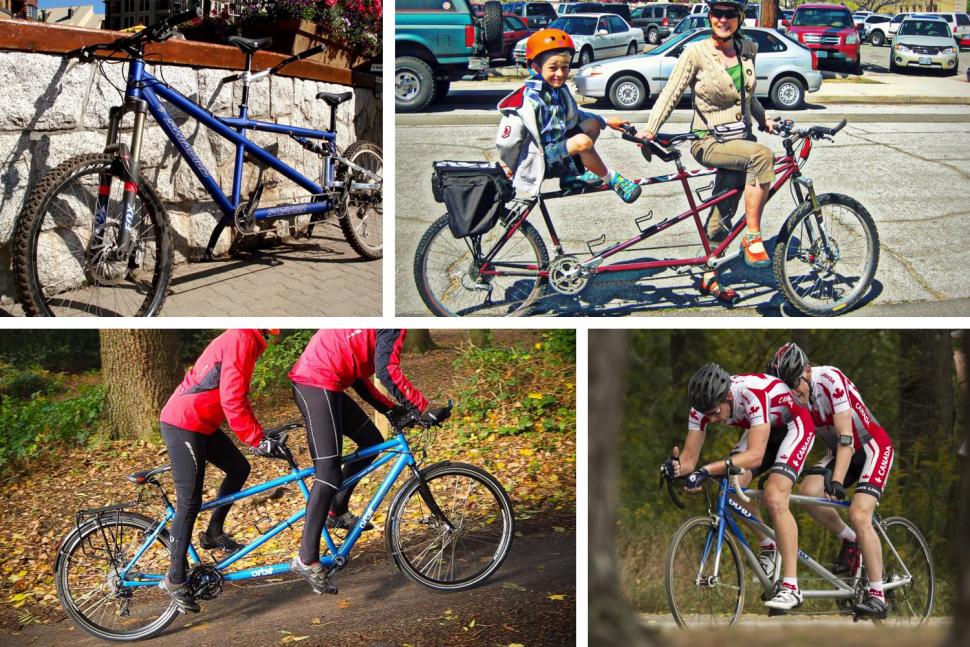 Buyers guide to tandems April 2019
Buyers guide to tandems April 2019Best tandem bikes 2025 — should you buy a bike made for two?
Updated April 25, 2021
A tandem bike can be the secret to combining a relationship with a bike obsession: a bike built for two will enable cyclists of different fitness to ride together, and can even give you get an extra turn of speed compared to solo bikes – among other advantages. Let’s take a look at the reasons you should add a tandem to your fleet, and how to choose one of the best tandem bikes for you.
-
A tandem physically connects two riders so they can rider together even if one is much stronger or fitter than the other
-
The extra material and mechanical complication of a tandem pushes the price up compared to a solo; decent tandems start at around £1,000
-
Tandems are faster than solo bikes downhill and on the flat; uphill speed depends on the fitness and coordination of both riders
-
Riding a tandem can be a serious test of a relationship or friendship, but when you get in synch, whizzing along with only moderate effort is lots of fun
-
Any bike with seats behind one another is a tandem; the term comes from Latin and was originally used to refer to horses harnessed "at length", that is, in a single line. A side-by-side two-seater bike is a sociable
There is a saying that couples who play together stay together; sharing an activity can really strengthen a relationship, whether it’s walking the dog, skydiving or riding a bike. But for many couples the problem with cycling together is that one party is often fitter, or stronger, or more experienced, or more skilled, or has better equipment than the other. That leads to frustration on both sides as they fail to actually be together during the ride.
A tandem can solve this. You’re on the same bike, so you can’t get separated, but there’s more to it than that. A tandem takes both riders’ power and puts it through the same transmission so it doesn’t matter if one rider is working harder than the other. Although you both have to pedal at the same cadence, you can hammer while your partner soft-pedals and you’ll still arrive together.
A suitable tandem can even be a great way to introduce children to the skills of riding a bike on the road, and many parents prefer it to small solo bikes or a trailer bike.
Teamwork
This requires teamwork. The captain—the rider up front—has sole responsibility for brakes, gears and steering, but has to avoid sudden changes of direction, and to let the stoker know what’s going on, because visibility straight ahead is limited from the back seat. It’s vital that the captain warn of major changes of pace, anything that could wobble the stoker around, and especially imminent bumps and potholes.
The stoker is responsible for pedalling, waving at people, taking the mickey out of the captain, and generally admiring the scenery and wildlife. He or she may also be in charge of signalling, taking pictures, and positioning the pedals before pushing off. It’s important that the stoker sits reasonably still; start jumping around and you can seriously unbalance the bike.
Nowhere is such teamwork more important then when the stoker is visually impaired; this is not just something for competitive cyclists, as there are various bodies around the country that use tandems to give blind and partially-sighted people the experience of cycling. The Tandem Club lists a few, including Charlotte’s Tandems.
Both parties must accept that the other may have a different capacity for effort, so if one is flagging (or is weaker) the other should look upon it as an opportunity to have a better workout whilst giving his or her partner a more enjoyable experience.
If you decide that you do want to ‘play together’, pitching the idea of a tandem has to be worth trying. If you’re successful, you have automatic support in the ‘n+1’ discussion, and the alternative might be that you are encouraged to take up your partner’s chosen activity.
Once you have agreement to proceed you will need to put some work into maintaining that enthusiasm during the initial teething difficulties - and in my experience the best way to achieve that is by making sure that your partner enjoys the ride every time. That doesn’t just mean agreeing to visit a pub or coffee shop, but it is more about not suffering machine malfunctions, not being uncomfortable, not suffering unnecessarily, not being made to feel nervous, not having disagreements, and so on.
When you are out cycling you will find that for some reason the public often like to shout comments to tandem riders as they pass - but unlike solo bikes these are nearly always supportive or jocular. By far and away the most common call that you will hear is “she’s not pedalling”, which is a standing joke in tandem circles.
More imaginative types shout “she’s behind you”, and occasionally we hear “I want one of those” when passing solo cyclists. Perhaps we might hear “she’s not social-distancing!” now, or “that’s not two metres apart!”
If you ever ride a tandem on your own, such as on the school run, you might even hear “she’s fallen off the back”. And of course there’s “can you ride tandem?” from bystanders old enough to remember the PG Tips chimps.
Need for speed
A tandem has the weight and power of two riders, but its aerodynamic drag is only a bit more than a solo. This means a tandem is a bit faster on the flat than a solo, and a lot faster on descents. It’s not hard to hit well over 50mph on a fairly moderate downhill, and tandems—sometimes with as many as five riders providing the power—were used as pacing machines for track racing and the 600km Bordeaux-Paris race before the advent of derny bikes.
Tandems have a reputation for being slower uphill than solos. Many tandem teams comprise one faster and one slower rider, so their average power-to-weight ratio is lower than a fit rider on a solo, and they’re slower uphill. But a pair of fit, experienced riders who are used to riding together give little or nothing away to a solo on climbs except the ability to accelerate quickly.
Not surprisingly, electric assistance is happening on tandems in just the same way as on solo bikes, and the advantages are similar. However, it is worth bearing in mind that you are still limited by the 250 watt maximum power output per bike, which will of course be spread over two riders. On that basis you might think that two powered solo bikes make more sense, each with your own 250 watts of extra assistance - but then you won’t get all the other benefits of the tandem experience.
You will also find that (except in some rare instances) the cranks on electric-assist tandems are not kept in sync. For experienced tandem riders this will feel odd, and certainly makes getting out of the saddle together more of a challenge.
Try before you buy
The first rule of tandem life is to take a trial run with your partner to check your on-bike compatibility before fully committing. It does not matter how good a rider you are, if you can’t work together as a team it will be a miserable experience for both, but get it right and both parties will feel the benefit. To put it another way, a team of two strong but incompatible riders will make 2 + 2 = 3, whereas a pair with different strengths who can work well together will make 2 + 1 = 4.
Unfortunately a test ride is not always easy. Tandems are rare beasts, and dealers that work with them are even rarer. One of the best options available, and one that I can recommend from personal experience, is a visit to JD Tandems in Yorkshire.
Tucked away on an industrial estate in Gargrave near Skipton, JD is very much a specialist ‘destination store’; here you will find up to 40 tandems on display from at least 7 different brands – and every one of them is available for a free test ride. From a wide selection of conventional tandems through to electric, folding, and semi-recumbent machines, there are enough options to satisfy anyone.
You can also pay for an accompanied one-day ‘Tandem Experience’, and have the fee deducted from any subsequent purchase.
Circe Cycles also offer test rides, and a ‘hire to buy’ scheme, whereby the cost of a tandem hire will be deducted from a purchase. Apparently weekend hires play a part in quite a few weddings. We tested a Circe EOS tandem with twin belt drives. Here's a sneak peek at it:
St. John Street Cycles also has a good reputation for their extensive range of Thorn branded tandems.
Just remember that it as much a test of your partnership as it is of the bike. It is often said that whichever way your relationship is going, a tandem will take you there more quickly – so, just as in everyday life, a bit of compromise from both sides will go a long way to ensuring harmony.
Living with a tandem
One issue that you will need to consider is how to store or transport the machine. If you think that’s difficult with a solo bike, the challenge is greatly increased with a tandem, and having a ready solution will help your cause. On some tandems it is possible to partly address the issue with S & S couplings, which is probably the best-known method to allow frames to be broken down into small sections. But when you realise that it costs the best part of £2,000 to fit a tandem’s worth of couplings this is hardly the sort of thing that a first-time buyer would consider.
Similar results can be achieved by using the Ritchey Break-away system on a tandem frame, or the ‘separable system’ from Circe Cycles.
As a rule of thumb, a tandem will cost at least twice the price of a solo bike with a similar looking specification, so you should expect the performance of a £2,000 machine to be comparable to a good solo bike costing around £1,000. If you spend the same amount on a tandem as your solo bike, don’t expect them to perform to the same level.
In some cases the reason for the extra cost of a tandem is obvious: there are twice as many ‘contact points’, i.e. saddles, pedals, and bars, there is nearly twice as much frame and there’s that extra chain and crankset in the middle.
However, some of the increased cost comes from the use of specialist parts that help to make riding a tandem fun and reliable. Components like beefed up hubs and highly-adjustable rear stems are designed to cope with the greater forces or different dimensions on a tandem, and with the lower production volumes they simply cost more.
As general rule, higher price machines will use more of these specialist parts, whereas cheaper machines will be forced to use more solo bike components to keep the price down.
You won’t find the tandem equivalent of a BSO (Bicycle Shaped Object) for only a few hundred pounds, as the extra complexity and low volumes make the category unappealing to the mass market brands. Brands such as Simmonshohn and Viking have produced machines at around £500 in the past, but Viking's don't seem to be available at the time of writing and nor do Simmonsohn's which started at £850 last time they were available. Things really start to get interesting as you approach £1,000, which is where some mainstream brands such as Dawes enter the fray.
There seems to be a sweetspot for tandems as you approach £2,000, with more brands and significantly better machinery on offer. For specialist brands such as Orbit or Thorn this is merely the start of a range that really does justify the comment “you could buy a car for that price” at the other end.
As prices climb towards £3,000 and beyond, the machinery does get better, but it is case of diminishing returns: just as with solo bikes, a doubling of price does not bring twice the performance – although you do find some very nice bikes.
Frame
A good tandem frame is more than just two solo frames stuck together, but many people have done that over the years – although not normally as well as the late great Sheldon Brown.
A tandem frame has to contend with more power, weight, and length, and if the frame is not stiff enough it will introduce unwelcome flexibility in the bike and a general vagueness to the handling. Extreme stiffness may be unwelcome on a solo bike, but it is much more desirable on a tandem.
Getting out of the saddle together and standing on the pedals when appropriate is just as welcome and effective on a tandem as on a solo machine. The necessary synchronisation can be hard enough to achieve at the best of times, but a flexible frame will make it considerably harder to master.
Some brands try to minimise this flex by keeping the overall length of the machine short, mainly by reducing the space given to the rear cockpit. Not surprisingly this makes for a cramped and uncomfortable experience at the back, and gives tandems a bad name. If the frame is stiff enough this is unnecessary, and the best way to achieve that is through tandem-specific choices to tube diameter and/or wall thickness – all of which cost a bit more.
When it comes to sizing, not only do both riders need a suitable size, but that particular combination needs to be available as well. It is customary to put the larger rider on the front, especially if he or she has the greater cycling experience, regardless of who normally ‘wears the trousers’, and standard size options reflect that. Brands can save money by offering fewer frame size combinations, but then the chance of one or both riders having to compromise is increased.
Circe Cycles offers an alternative solution with their versatile Helios tandem, where a combination of small wheels, a low-stand-over height, and a wide-range of adjustment make it as close as you can get to a ‘one size fits all’ machine.
Although a tandem is never going to handle the same as a bike-for-one, a good one will give you the confidence to do almost anything that you would on a solo bike: you just have to remember about the longer wheelbase when turning, avoiding potholes, interacting with traffic, etc., and be aware of the increased risk of grounding something over rough ground.
As with any bike purchase, there will be some component choices to make, but with some extra considerations in areas where it does not pay to cut corners on a tandem.
Wheels
Wheels have a harder life on a tandem than a solo because they’re carrying twice as much weight, so this is not an area for economising.
Most tandem wheels follow the theory that more spokes make for a stronger wheel, so ‘proper’ tandem wheels will have 40 spokes, or even 48 for heavy-duty use. However, more spokes are not a substitute for a well-built wheel, so it is best to aim for both.
If you are generally light on your equipment you might be fine with 36 spokes, especially on smaller wheels, as long as top quality components are combined with good wheel building: I have been using the same 36 spoke 26-inch wheels for 13 years without problem, although rarely over rough ground or with heavy loads.
Most rear tandem hubs are 145mm wide, as this reduces the amount of dish over the 135 mm you find on mountain bikes, resulting in a more even spoke balance and improved strength. Front hubs use the regular 100 mm standard.
The only special consideration for the tyres that I would recommend is trying to avoid sidewall failure, which can afflict tandems disproportionately; this may not be the place to use the lightest carcass in a tyre’s range.
Transmission
You will almost certainly want both higher and lower gears on your tandem than on a solo, even on the same roads because you’ll be going faster on descents and the flat, and probably slower on the climbs, especially if one rider is tired.
Tandems often rely on a triple chainset to get a sufficiently wide gear range, though manufacturers can now combine a double (or even single) chainset with a wide-range mountain bike cassette to achieve a less-complicated set-up.
Wide-range hub-gears may be sufficient for your needs, with the Rohloff hub being the pinnacle.
For me the ability to change the gearing on a tandem to suit your needs (once you know what they are) is as important as the standard specification. If you find that you need higher or lower gears for a particular ride then you want to be able to achieve this with only a change of chainring or cassette, and not shifters, derailleurs, and chainsets as well.
You don’t have to put up with a gear range that does not meet your requirements, especially if it is likely to reduce the enjoyment of a ride and remember that it is not just your opinion that counts!
If you have different size riders you are likely to want different length cranks for each – and tandem-specific chainsets offer that. The combination of 175mm front and 170mm rear is fairly standard, and higher price chainsets often have more options.
Whatever crank size you normally ride, having a difference between lengths is especially useful if each rider has a different natural cadence, as shorter cranks make it feel easier to pedal fast - just as longer cranks make it feel harder. If you are lucky then neither of you will have to compromise much on your preferred pedalling action.
Brakes
Every argument in the debate about rim versus disc brakes applies here, just to a greater degree: not only does a tandem have more mass to control, it can also make better use of very powerful brakes than any solo, because both wheels have much more weight on them to help with grip, and the distribution of that weight makes it harder to lock up the rear wheel or pitch over the bars.
In that respect, if you go with disc brakes, then there is no reason not to run the largest diameter rotors the machine will accept, front and rear. However, be aware that this can put enormous forces through the fork, so it must be designed for the job. You can’t just sling a solo fork on a tandem.
Rim brakes can perform perfectly well in most situations, as long as they are of good quality and well-adjusted; we have successfully descended numerous passes in the Lake District, Alps, Pyrenees, and Dolomites with just two V-brakes. If you add in heavy luggage or wet roads, then obviously more care is required, just as it would be on a solo bike.
Tandem specifics
There are a few points to cover that won’t normally be a consideration when buying a solo bike. One is a suspension seatpost at the rear. The stoker does not have a good view of the road immediately ahead and so cannot prepare for rough surfaces by lifting his or her weight off the saddle. For some people it is not a problem, but for others the bounciness is worth it to take the sting out of rough surfaces.
Even more tandem-specific is a third brake: it can be used as a supplement to the main brakes when moving, but has even more value as a parking brake. I don’t like the idea of using them as a ‘drag brake’, because of the risk of overheating. If you have one, I suggest that it is best for it to be controlled by the captain rather than the stoker (along with all the other controls), otherwise each end of the bike might have different opinions as to when to activate it.
A tandem needs to connect the two riders’ pedals so that both power the bike. The most common way to do with is with a cross-over drive, which has single chainrings on the left, connected by a timing chain. As with many specialist tandem parts, a crossover drive is more expensive than two standard chainsets, mostly as a result of the small numbers made. Some older tandems put the timing chain on the right, connected to the inner ring of a triple chainset. This means a pair of conventional chainsets can be used, but only the outer two chainrings are used as the final drive.
Conclusion
Life with a tandem will not suit everybody, but if you are lucky enough to have a compatible partner it is a great way to share experiences while doing your favourite activity. If you do go ahead, then it is important that both parties find it an enjoyable experience every time: work on that aspect, and if you are lucky then (like me) you will start to hear requests for upgraded equipment and ever more adventurous trips.
About road.cc Buyer's Guides
The aim of road.cc buyer's guides is to give you the most, authoritative, objective and up-to-date buying advice. We continuously update and republish our guides, checking prices, availability and looking for the best deals.
Our guides include links to websites where you can buy the featured products. Like most sites we make a small amount of money if you buy something after clicking on one of those links. We want you to be happy with what you buy, so we only include a product if we think it's one of the best of its kind.
As far as possible that means recommending equipment that we have actually reviewed, but we also include products that are popular, highly-regarded benchmarks in their categories.
Here's some more information on how road.cc makes money.
You can also find further guides on our sister sites off.road.cc and ebiketips.
road.cc buyer's guides are maintained by the road.cc tech team. Email us with comments, corrections or queries.
Latest Comments
- stonojnr 3 sec ago
Technically no, it was drawn up by civil servants in the department, unless you think she typed it all out herself ?...
- Geoff H 8 min 26 sec ago
ALERT!!! SAVE 100%!!! Stay home!
- Geoff H 27 min 30 sec ago
Deflect. Deflect! DEFLECT!! If the lad was in the drivers 'blind spot' no amount of high-viz and lights would have done any good. There is NO...
- andyk 30 min 34 sec ago
Hi Griff, unfirtunately one of the key measurements isn't bigger - the stack - it's the same on the 54 SL8 - 544mm, as the 54cm Addict 543.3mm, so...
- Geoff H 38 min 9 sec ago
Didn't the police (in regards to thefts) say solve your own issuses? Without their assistance the police are promoting vigilante-ism. Laz (below)...
- chrisonabike 1 hour 54 sec ago
At least today it's a case of "more haste, less speed" (as that was replaced by steroids, EPO, blood doping...)...
- Hirsute 1 hour 38 min ago
"The paste inside is crafted from 100% Fairtrade Arabica beans and sweetened with organic Swiss beet sugar. " Why would I want sugar ?
- RafaDy 2 hours 4 min ago
Is he returning it? 30 days returns policy at Ribble.
- Rendel Harris 3 hours 28 min ago
Yes, that's exactly what it's supposed to be as we were talking about why if you apply mathematical principles to the phrase "That's three times...
- Rendel Harris 3 hours 56 min ago
A good saving no doubt, especially if you're working on rrp for the groupset and wheels, but with 105 Di2 available from multiple retailers for ...
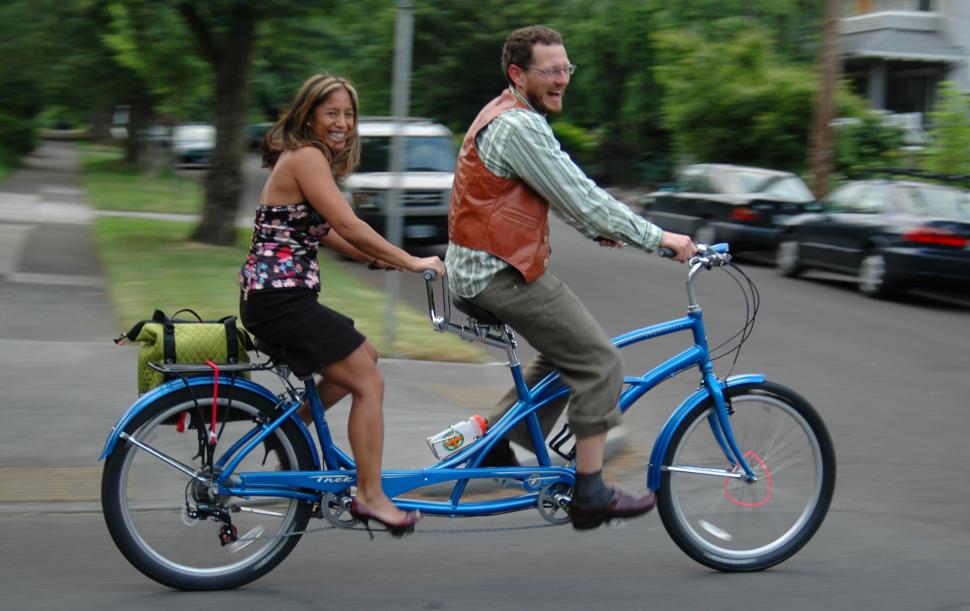





























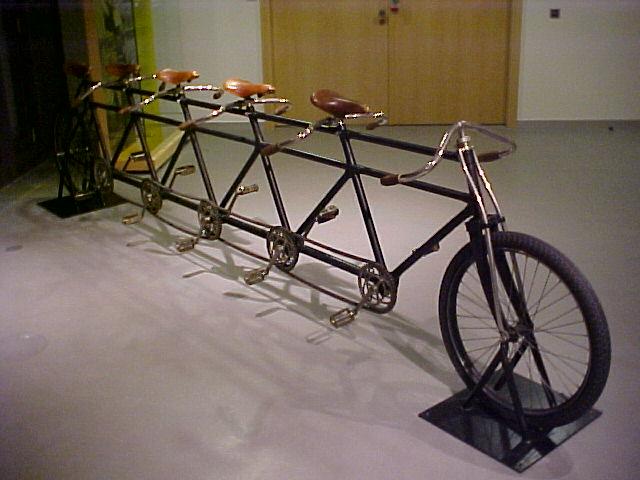
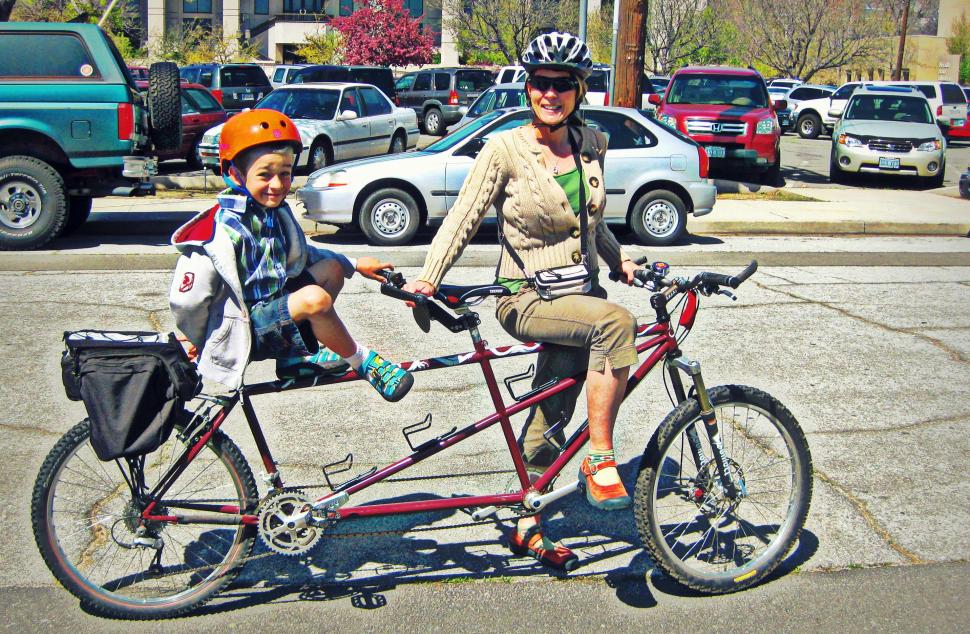
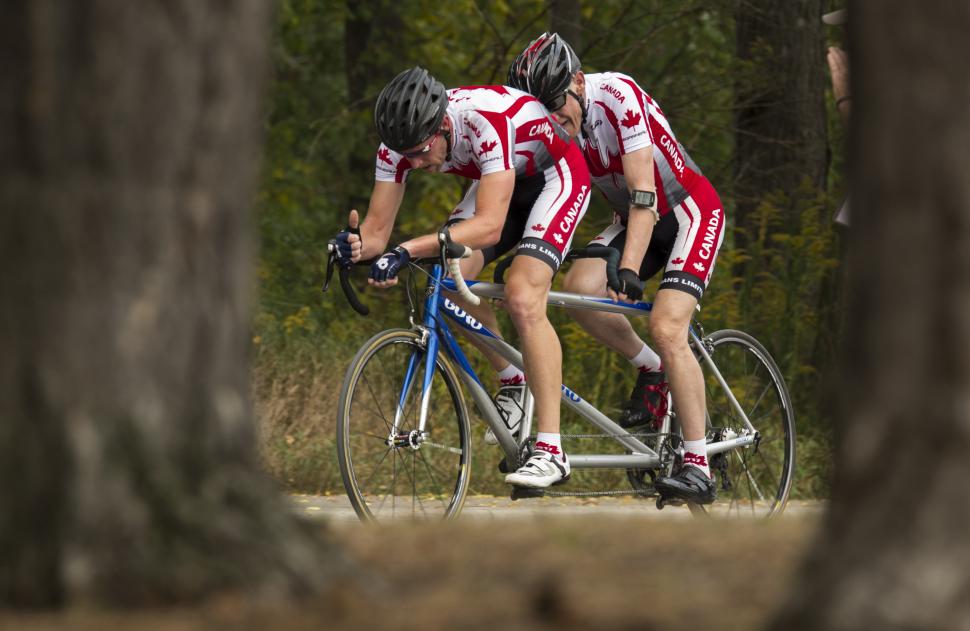
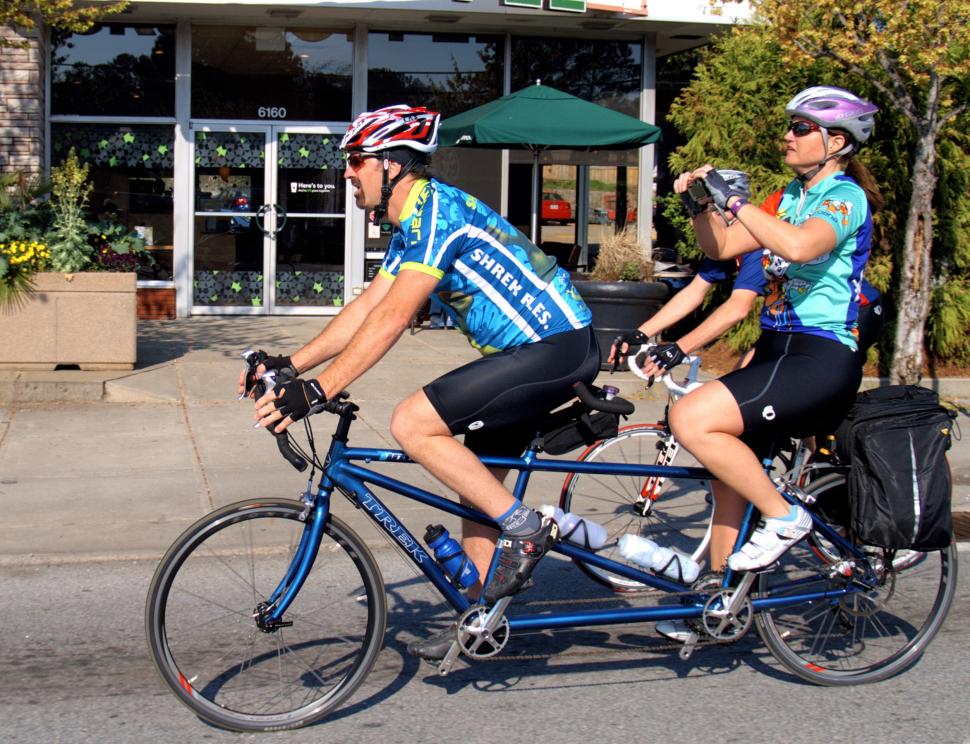
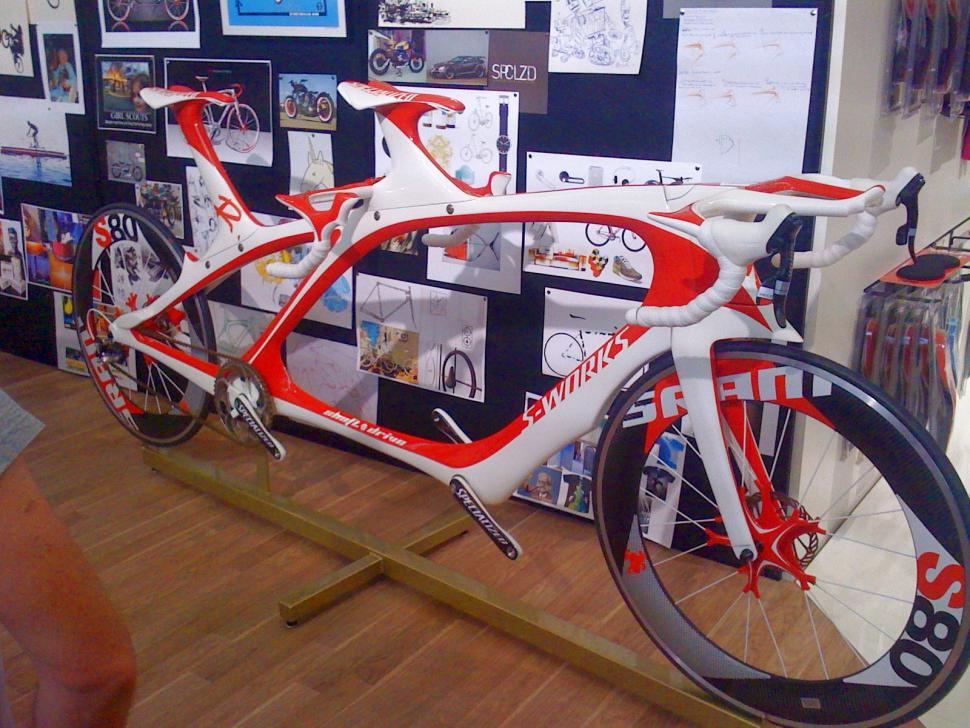
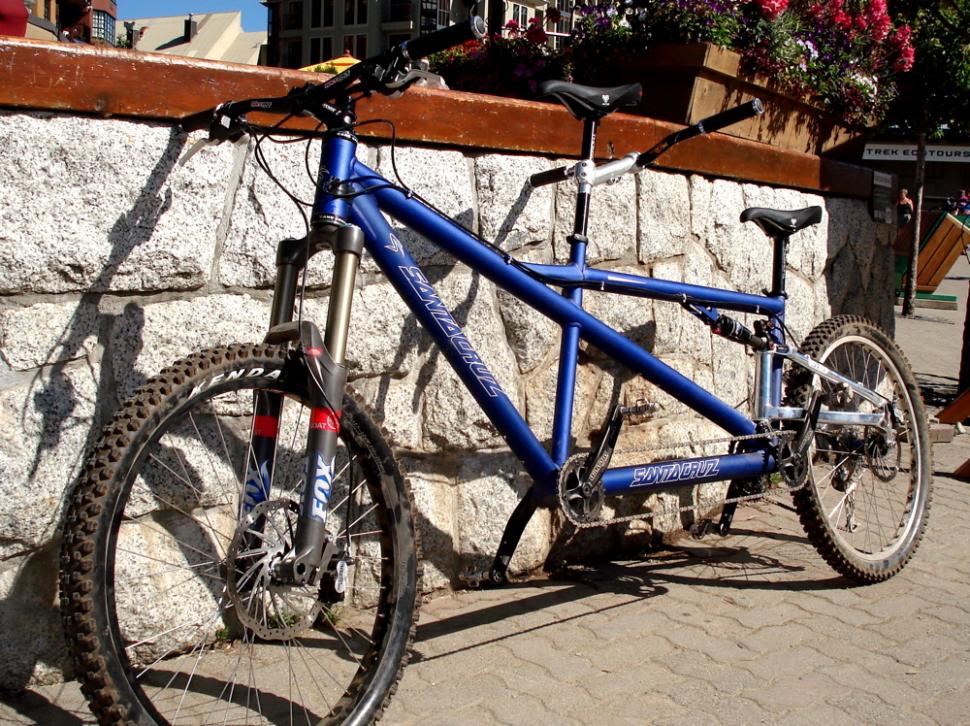
Add new comment
40 comments
Hear, hear!
While we're at it, a big up for http://simply-cycling.org/ in Manchester that offer sessions on a range of tandems and adapted bikes/trikes at three athletics track locations, and weekend ride outs on roads/cyclepaths.
Good article, but to correct one point, new tandems are available for a few hundred pounds, e.g. try Viking tandems on EBay.
We have lots of them in our fleet at Charlotte's Tandems and they are a great starter tandem.
Charlotte's Tandems lend tandems for free to anyone with a special need or disability throughout the UK and Ireland. For full details, see CharlottesTandems.co.uk
I've had a tandem for a few years, although it doesn't come out very often.
You'll need extra long, tandem-specific cables for the rear brake and mech, with associated extra stretch and friction in the outers, so lube them well. I've added a couple of extra bits of outer zip-tied to the frame as guides, to stop a long length of inner flapping around and potentially getting caught on clothing. You'll probably get away with a normal cable for the front mech. If you're on hydraulic discs, you'll need a long hose, so find somewhere that cuts it off a reel.
Mine has a 3-brake set-up. The front right lever is tandem-specific and takes 2 cables to operate both the front and rear rim brakes simultaneously, which needs a bit of careful pad spacing to get even braking. The front left lever operates a rear hub brake for a bit more brake when you need it.
Communication is key, to let the stoker know what's going on up front. Get them to do any hand signals - easier for drivers behind to see it and leaves you free to concentrate on the traffic and brakes.
Just as important is anticipation - where possible, timing junctions/roundabouts to catch a gap in traffic is far preferable to having to stop and get going again.
No-one told us that you should have the bigger, heavier rider on the front, so we had him on the back, as not as confident with the controls. Does mean that they can see over your head, reducing the need for communication, at the expense of being a bit more twitchy.
You can ride a tandem solo, which is handy for nipping round to pick a mate up, or something, but brings it's own problems. I once ended up powersliding mine round a roundabout when a foreign driver started to pull out on me - the lack of weight over the back tyre and a slightly damp road meant it started to break away when I put the brakes on. Fortunately managed to recover it and carry on. There's also a danger that drivers may well hit the back wheel if they think you're actually on a solo bike.
Ditto above. We got a (british designed) Helios mainly to transport our kids - which it is fabulous for - but also use it for two adults when needed. It is particularly handy for picking up a child from a playdate, or when my hand was in a cast and I couldn't ride solo.
The Helios, which has 20" wheels, fits kids from 3.5 yo , and is small enough to fit most trains. this also make storage easier.
In Edinburgh, Helios can be tried or rented from Laidback bikes, but a lot of us evangelistic owners will also loan out our bikes for a trial run.
We use a BikeFriday family tandem for similar errands. It breaks down into two sets of tubes packable in suitcases for transport or for storage.
Another very happy Helios owner here. I started using it as a cargo bike with two child seats mounted in series. I've just returned it to Circe cycles to have the frame cut so that it is now a triplet (and separable to boot). It's a fantastic machine, and I can't recommend it highly enough. I detest driving in the city, and being on the same frame as my kids is the only way I feel confident to bike with them on anything other than very quiet roads. They can kick out a reasonable bit of power too, when we need to get up hills or sprint off from traffic lights.
If you live in South London, tandems, recumbents and special needs bikes can be hired by the hour from London Recumbents in Battersea Park and Dulwich Park - see www.londonrecumbents.co.uk.
Cycling slowly round the park on a tandem for an hour can be a good way of trying one out before
deciding whether to buy.
Great article. Two further points to make are that
1) Some manufacturers make tandems with a small frame at the back
( we have a Dawes Duet which has 20" at the front and 13" at the back)
which is great if your wife is small (as mine is) or for taking the children out.
2) A tandem can be ridden with just the captain ( no stoker ) which means you can
( for example as I have done ) cycle with your child to school, drop her off and
then cycle on "solo " to work ( be ready for the " she's fallen off the back " comments.
Every time I look at the prices and geometry of tandem bikes I end up thinking of getting her indoors an e-bike instead...
Good stuff. My tip to anyone looking to try out a tandem is for the stoker to lightly rest their feet on the pedals when moving away from a standstill if the gradient permits. I just say “pedal” when I’m moving along comfortably - it avoids fighting one another, which can sometimes happen when captain and stoker are initially out of synch. Go for it, folks!
Pages